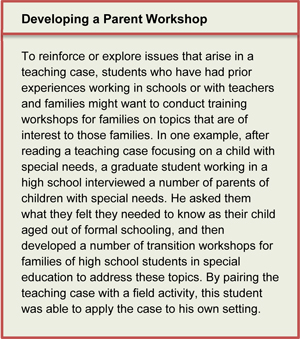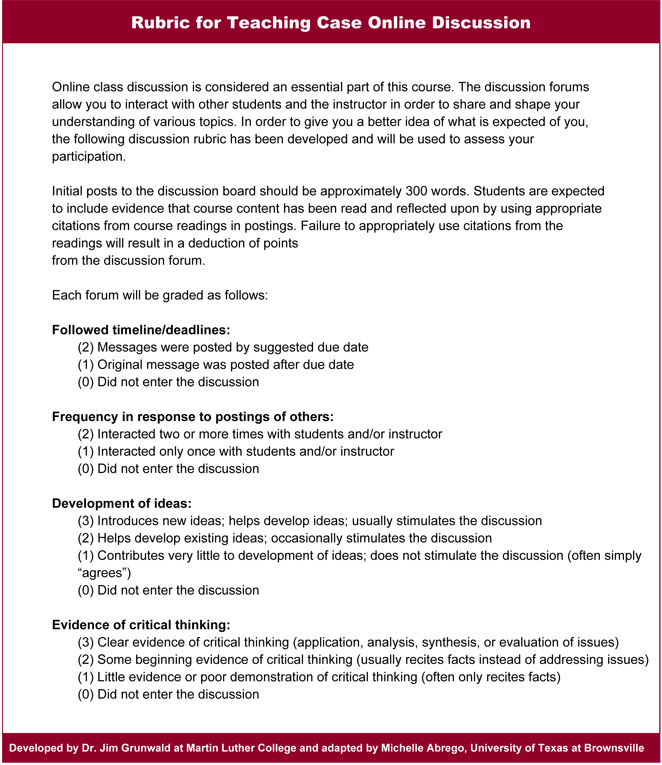The Harvard Family Research Project separated from the Harvard Graduate School of Education to become the Global Family Research Project as of January 1, 2017. It is no longer affiliated with Harvard University.

|
December 5, 2013 Six Activities to Spice Up the Teaching Case Method DiscussionMargaret Caspe
|
FINE Newsletter, Volume V, Issue 4
Issue Topic: Innovative Approaches to Preparing and Training Educators for Family Engagement
Voices From the Field
This article is based on a series of interviews and email conversations that Margaret Caspe conducted with users of Harvard Family Research Project’s Family Engagement Teaching Cases to better understand the types of instructional opportunities in which cases are used, the potential impact they are having, and the types of activities with which teaching cases can be coupled. Margaret Caspe is an education and research consultant.

A POWERFUL TOOL FOR PREPARING FUTURE EDUCATORS1 FOR FAMILY ENGAGEMENT
Family engagement teaching cases can be a compelling means of preparing educators for family engagement and can benefit both instructors and learners. For instructors, the teaching case method provides a foundation around which they can structure interesting and relevant class activities that deviate from the formal lecture. Because teaching cases incorporate the points of view of family members, children, teachers, and others, instructors are able to encourage a vibrant exchange of ideas and responses from class participants as they imagine and discuss the situation of each character. Instructors are able to develop a broad range of creative and persuasive questions to address practical issues that students might face in their work with families and schools.
As active participants in class discussions, students can gain a deep appreciation for the complexity of the relationships among and between children, parents, school personnel, and community providers. Race, culture, and class divisions provide the context for most of the cases developed by HFRP, so through these readings, students are exposed to the perspectives of parents, children, and other family members that they may not encounter in their day-to-day experiences.2 Through guided discussions, students can develop the valuable ability to take an open-minded approach to their family engagement work. Teaching case discussions prompt students to reflect on the ways in which their opinions of the role of schools and families may differ from the opinions of others; the discussions also prompt students to change perspectives as alternative viewpoints and varying courses of action are considered throughout the conversation.
In order for teaching cases to be effective at preparing educators to engage families, students need to be invested in the process and to be meaningfully engaged with the cases. However, as we learned through interviews conducted with case users,3 students sometimes are too detached from the narrative. Instructors have found that some of their students from middle- or upper-class homes and ethnic majority families envision themselves working in school districts like the ones they grew up in and have trouble identifying with the schools and characters described in the cases. Other students have difficulty recognizing and challenging their own biases and assumptions about culture and class. For these reasons, using the teaching case on its own often isn’t enough. Students may need more support, guidance, or information to engage with a case on the most meaningful level possible and to appreciate the strengths that all families possess.
WHEN DISCUSSION IS NOT ENOUGH: A MENU OF ACTIVITIES TO COMPLEMENT THE TEACHING CASE DIALOGUE
From our interviews we learned of the following six types of activities that can be paired with teaching cases to increase discussion and help students better manage the predicaments presented in the cases.
|
In a different example, before introducing a case discussion on how low-income families might balance employment obligations and engagement in children’s learning at home and school, an instructor might ask students to think about building an ideal budget for a family with young children. The instructor could then introduce poverty income thresholds and force students to make hard decisions about which budget lines to keep and which to cut. Having to think about such issues so carefully primes students to approach the case with a more concrete sense of what the life of a low-income family might be like. The students are then better able to brainstorm innovative ways that the school and community can support working families and their engagement in children’s learning.4 |
||||
|
Another approach would be for instructors to ask students to take the perspective of one of the case characters. Assuming the perspective of a case character, students complete checklists or questionnaires about beliefs and values about family engagement in children’s learning. Thinking through these questions from the point of view of a character allows learners to explore how teachers, families, or other education staff members might fundamentally agree or disagree on certain issues. Doing so can also force learners to rethink the roles of the family and school in different situations.5 |
||||
|
|
||||
|
 conversations with families and receive feedback on their style and content. Two to four students, for example, might take on a role from a teaching case (e.g., the teacher, parent, child, or guidance counselor), sit at a round table in a classroom, and conduct a mock meeting to address the needs of each of the characters—acting out what they imagine an individual character might say. Students not chosen for the role play might observe and take notes on the role play as it is unfolding and provide feedback after the role play is completed. conversations with families and receive feedback on their style and content. Two to four students, for example, might take on a role from a teaching case (e.g., the teacher, parent, child, or guidance counselor), sit at a round table in a classroom, and conduct a mock meeting to address the needs of each of the characters—acting out what they imagine an individual character might say. Students not chosen for the role play might observe and take notes on the role play as it is unfolding and provide feedback after the role play is completed.
Working with families directly. To reinforce or explore issues that arise in a teaching case, faculty can use activities that provide students hands-on experience working directly with families. For example, students may be required to interview families about their experiences with schools and about ways in which they are engaged in their children’s learning. By developing interview questions based on topics that emerge from cases, and through hearing stories that dovetail with particular issues from different cases, students gain further insight into the intricacies of the family engagement process. Students might also interview staff members from the family’s school about the school’s family engagement policies or write a case study that examines the strengths of a particular child and family. |
||||
|
||||
CONCLUSION
Taken together, these different types of activities present a menu of options for instructors to facilitate teaching cases beyond the case discussion, particularly when students are in need of additional guidance for the takeaway lessons of the case to become clear and concrete.
Do you have activities that you use with teaching cases that you find particularly helpful? If so, HFRP would love to hear about them! Please contact us at fine@gse.harvard.edu.

Figure 1
Rubric for Teaching Case Online Discussion
1 This article is primarily about the use of teaching cases with pre-service teachers and future educators. However, teaching cases and the menu of activities that complement them can and should be used at different points throughout a teacher’s career.
2 Weiss, H. B., Kreider, H., Lopez, M. E., & Chatman-Nelson, C. (2010). Preparing educators to engage families: Case studies using an ecological systems framework (2nd ed.). Thousand Oaks, CA: SAGE Publications.
3 In spring 2013, we interviewed university faculty members, early childhood and school personnel, and family and teacher trainers from nonprofit organizations about their use of these cases. The respondents were varied in the types of courses taught (e.g., graduate and undergraduate courses and professional development workshops) and represented diverse geographic regions. We would especially like to thank the following colleagues for their participation in these interviews: Michelle Abrego, Peg Bradley, Beth Day-Hariston, Anita Ede, Wanda Grant, Jon Lasser, Dana McDermott, Tina Moorehouse, Jesus Paz-Albo, and Rebecca Ward.
4 Thanks to Rebecca Ward for these activity ideas.
5 For these checklists and questionnaires and other organizing tools developed by Dana McDermott, please visit: http://www.sagepub.com/booksProdDesc.nav?prodId=Book228935#tabview=samples.
This resource is part of the December 2013 FINE Newsletter. The FINE Newsletter shares the newest and best family engagement research and resources from Harvard Family Research Project and other field leaders. To access the archives of past issues, please visit www.hfrp.org/FINENewsletter.

.jpg)

.jpg)
.jpg)

.jpg)